Manchester City Women have been keeping pace with the top of the league and are looking to regain the crown they last won in 2016. After a busy summer of signings including Ellen White, Laura Coombs, Aoife Mannion, and Matilde Fidalgo, City were looking to take the league by storm. However, an injury to starting right-back Mannion saw a void that needed to be filled quickly. With Fidalgo in and out of the team, Nick Cushing found an unusual solution to his problem by moving forward Janine Beckie into the vacant right-back position. The Canadian forward has filled in at right-back for the past few matches and has not looked too out of place.
This tactical analysis scout report will look at how Beckie has adapted to the role and investigate how the tactics have changed with her introduction.
How has she adapted to right-back?
Moving from an attack to defence can be a problem for some players especially given that a number of inside-forwards and wingers aren’t very defensive-minded. Beckie, however, has been able to seamlessly slot into the right-back position and transform it into her own. Taking advantage of her attacking nature, Beckie has been seen making marauding runs down the right flank more than when she was deployed as a striker and right-winger. Her performances have been largely impressive and as a result, the team as well. Playing from a deeper position has allowed her the space to run in to and take on the opposition full-back using her immense pace and acceleration. Statistically, Beckie has attempted 24 dribbles per 90 in four matches as a right-back as against the 11 she made as a centre-forward and 18 as a right-winger.
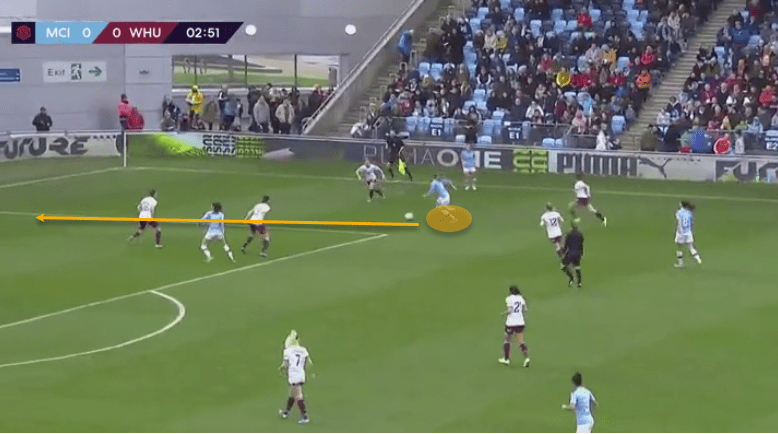
Many teams are now forced to drop their wingers back and double up against Beckie because of her immense pace. Giving her any sort of room to operate in is dangerous as it gives City and Beckie enough of a chance to create a goal-scoring opportunity. This example against West Ham Women shows us her intelligence and use of the ball even when she’s coming in at pace. Georgia Stanway holds up the ball against the full-back next to the touchline, allowing Beckie time to make a late run into the space in front of her. We can see there is enough space for her to run into with the momentum she brings in.
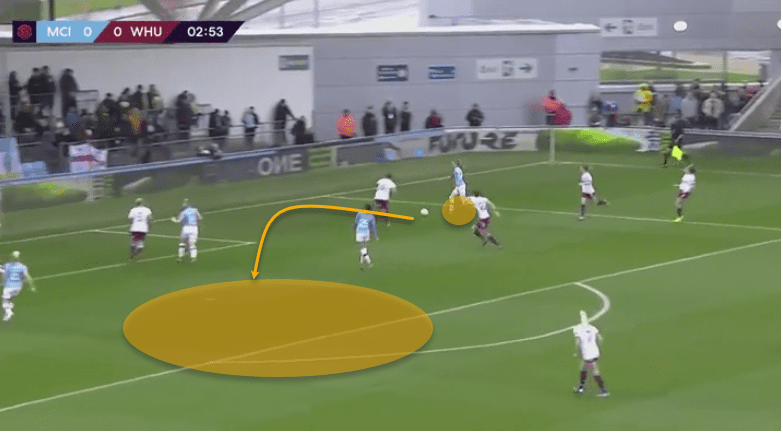
After she reaches the byline, we can see how her run along with Stanway’s hold up play has attracted four Spurs players away from the penalty area. This has given space to Jill Scott and White to operate in. While Beckie’s cross here was blocked, it shows how her purposeful running is an asset in these types of situations.
Another hallmark of her skillset is her crossing ability that wasn’t used to her full potential when playing further forward. Even here she’s attempted 35 crosses in her time as a right-back as compared to the 28 in her previous matches dating back to the start of the season. But, the difference now is she’s able to get into better crossing positions that originate from her intelligent movement. The Canadian forward has excelled in taking advantage of any space she finds and is able to interchange play with her teammates to exploit it. Once she is given time and space her lethal crossing ability comes into play and more often than not finds her intended target.
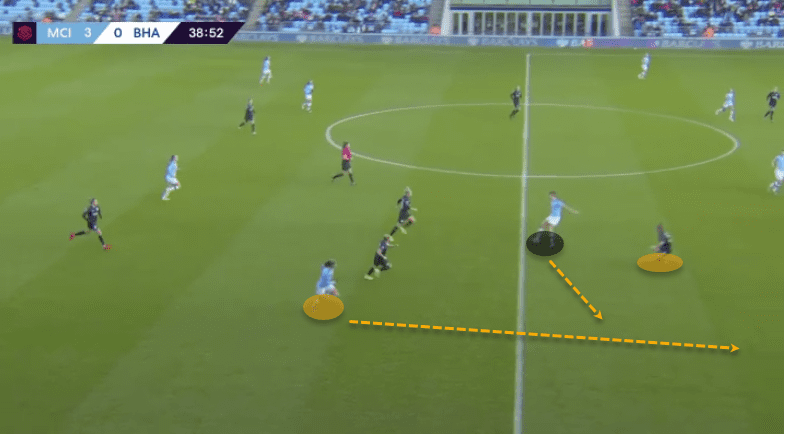
This passage of play starts with Beckie taking possession forward and interchange play with Scott in midfield to try and open space behind Liverpool’s defensive line. The quick play from Beckie eliminates the three players in midfield. The Liverpool full-back makes a mistake here by pushing forward towards Scott leaving space for the right-back to run into off the back of Scott’s return pass.
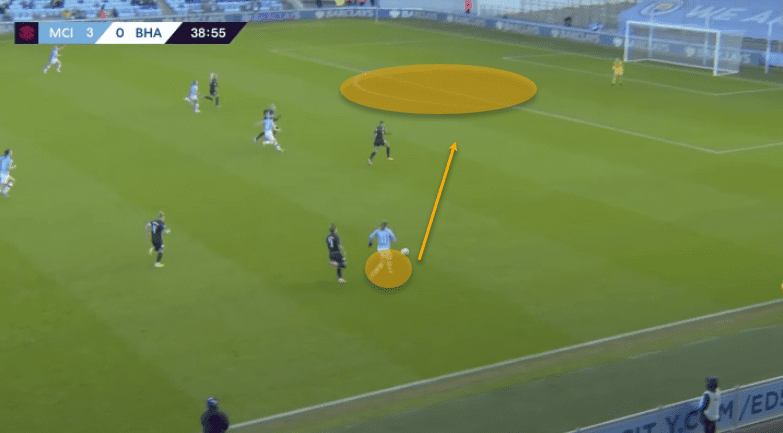
Here we can see how Beckie’s acceleration and speed has allowed her to exploit the space in behind. This now gives an opportunity to either play an early pass or drive down to the byline and move into a better crossing position. She ends up playing a pass just behind the defensive line when they were expecting a cross in front. This intelligent play causes the rest of the defence to overrun the City attacker giving them time to bring in reinforcements.
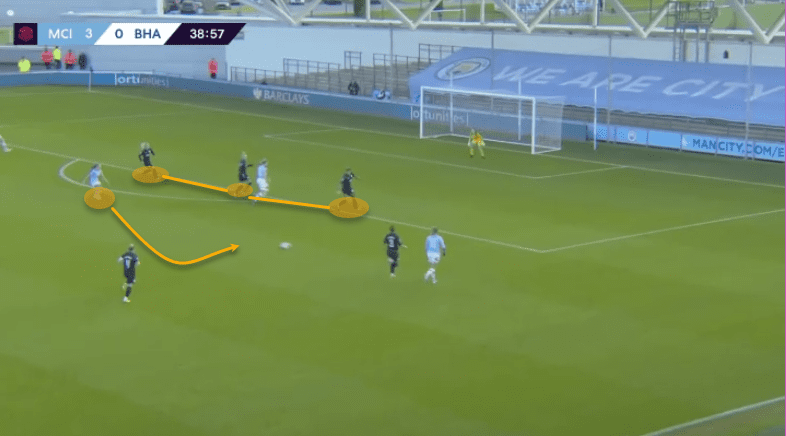
Beckie’s strength lies in her offensive capabilities, however, her defensive game has been relatively good. When an attacking player is asked to play in a more defensive role the limitations can often be exploited by the opposition and becomes a constant target point. City’s converted right-back has used her offensive skillset to her advantage in a defensive capacity. Her superior speed and intelligence have been used to intercept passes early and recover possession when caught high up the pitch. She averages 5.5 defensive duels and 3.5 interceptions per 90 which is quite okay for a marauding right-back. However, where her deficiencies lie is in her losses per 90 that average 12.06 per 90 with 16% coming in her own half confirming she spends most of her time in the opposition half.
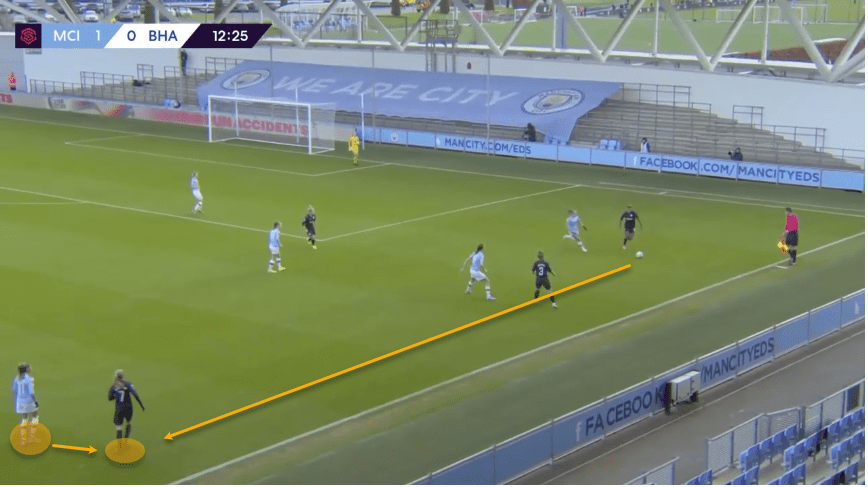
This example against Brighton & Hove Albion here shows how she uses her speed and quick thinking to win possession back high up the pitch. As the ball comes back down the flank, we can see Beckie already close to her marker and she is ready to gamble and win possession back.
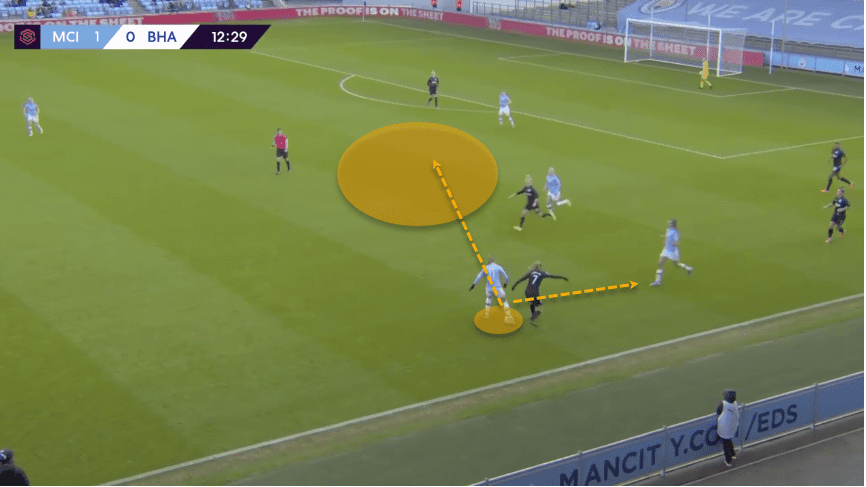
Beckie successfully wins possession back and is able to drive forward into space and play her teammates in a quick counter-attack. She has a number of options including a lofted pass into the space highlighted or a short pass into her closest teammate. While she isn’t the best 1v1 defender deep in her own half, she hasn’t had the need to deal with those situations as much because City have usually held the lion’s share of possession in the games they’ve played in. But, when she has needed to take on players in her own half, she will usually have support from her midfield.
Has Manchester City Women’s tactics changed?
Now that we’ve looked at Beckie and her performances at right-back, it is worth looking at the effect this has had on the team’s tactics. We will be looking at a couple of analysis metrics to understand if Beckie’s positional change has had a positive or negative effect on the team. Firstly, we’ll investigate the xGA and then delve into the team’s shape.
Taking a closer look at City’s xGA in the matches they’ve played with Beckie at right-back are as follows: 0.35, 0.82, 0.48, and 0.47. They’ve largely kept the opposition quiet and this becomes even more impressive when we see their xGA in the four games prior to her moving to right-back – 1.08, 1.24, 1.36, and 0.02. City conceded four goals three of which originated or ended up being scored from the right flank. So based on these statistics, City were having a tough time in limiting the opposition’s movement from the wide areas. While the xGA might be low, the goals are still coming from the wide areas and this is something teams could look to exploit going forward. Cushing has tried alleviating this issue by trying to use the midfielders to provide sufficient cover when Beckie bombs forward. We’ll explore and break down an example once we’ve understood how the tactics have changed.
Cushing employed a 4-2-2-2 formation for the game against Tottenham Hotspur, however, in reality, this was transitioned between a 4-2-2-2 in possession to an asymmetrical shape with Beckie turning into an auxiliary right-winger. When Mannion played, the two full-backs were balanced with Megan Campbell or Demi Stokes playing a more conservative role. A stark change has been the City defence adopting a three-man back line out of possession with Campbell tucking in to become the third centre-back. With Caroline Weir and Kiera Walsh play as conservative number ‘8s’ to give City protection in midfield. Walsh and Scott were tasked with providing extra cover on the right-hand side when Beckie made attacking runs down the flank. The two strikers in White and Pauline Bremer moved into good positions in and around the box to receive passes or cross from the wide areas.
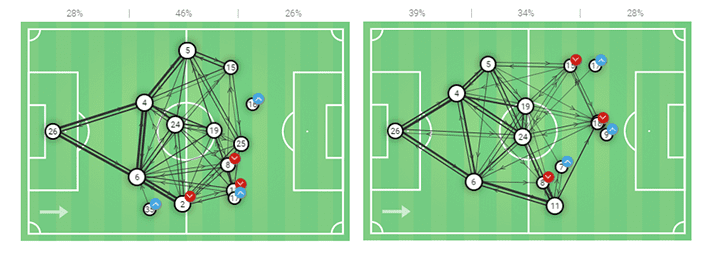
These pass maps are comparisons between games with Mannion, Fidalgo, and Beckie at right-back. The biggest difference is in their positioning. When both Mannion or Fidalgo played, City kept a more balanced shape with Walsh the only central midfielder protecting the centre-backs and Campbell holding the same line as Beckie. Another point to note is City played with a more attacking presence at right-wing. The pass map on the right shows City’s change in formation with Beckie holding a much higher position and essentially playing as both a full-back and auxiliary winger. Campbell has kept a much lower position and is closer to the centre-backs to form a back three.
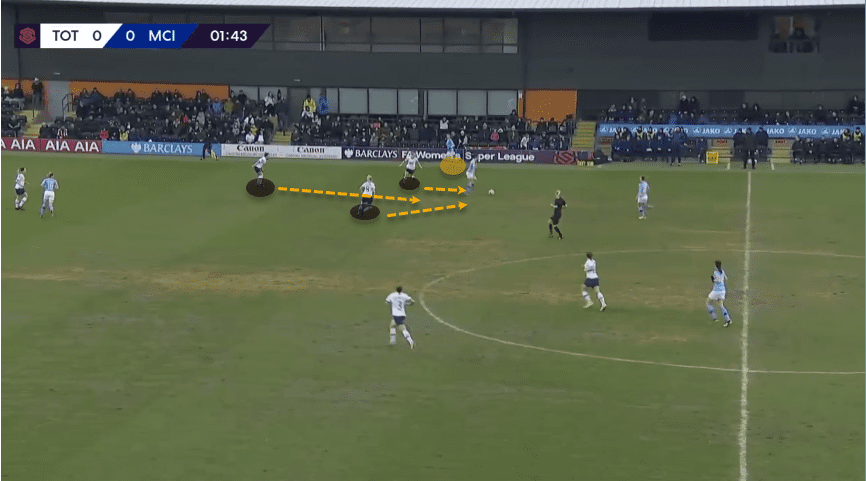
If we examine the first goal scored against Spurs last weekend, Beckie’s involvement is crucial in the build-up to the first goal. In this graphic, she plays a pass towards Scott and this has diverted the attention of the three Spurs midfielders. We can see Beckie moving forward on the overlap.
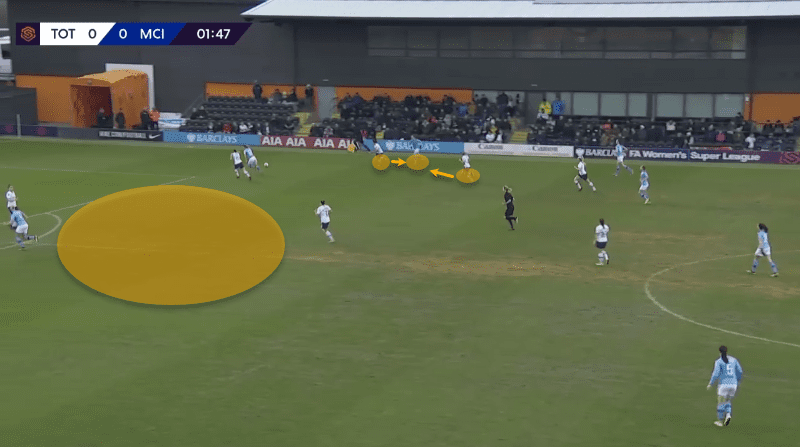
When Beckie plays the return pass into White’s path, this has allowed the England striker an opportunity to cross the ball towards Bremer who finishes the move expertly. However, what’s important to note here is Beckie’s intelligent movement forced the Spurs midfielders to first push higher up the pitch and secondly give them too much space to track back and cover the gap between the left-back and centre-back.
Comparison to Aoife Mannion
A comparison to Mannion makes sense to round off the analysis and really look to see how Beckie stacks up against her teammate. For this comparison, we’ve examined both the attacking and defensive statistics to see where Beckie excels and if the analysis we’ve made earlier correlates to these numbers.
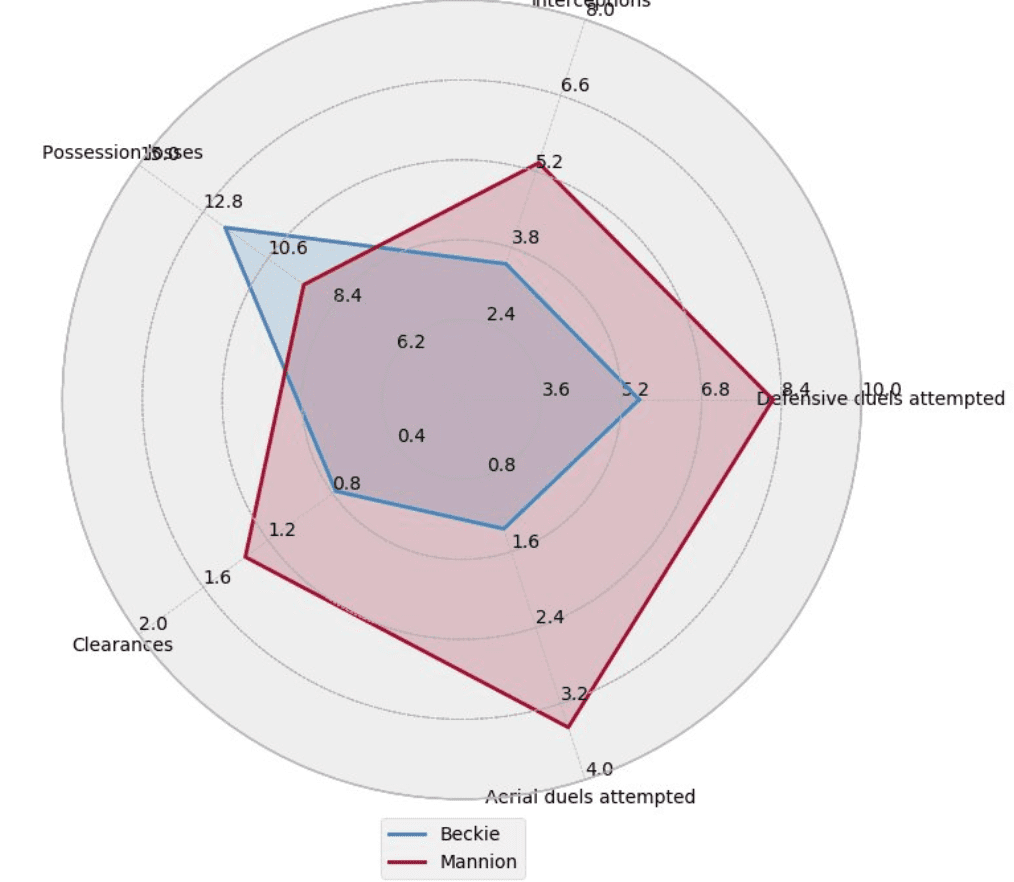
Firstly, we’ll examine the defensive statistics between the two players. What jumps out the most is Mannion’s defensive ability stands out and is much better than the attack-minded Beckie. Not only does she attempt more interceptions and defensive duels but she loses possession on fewer occasions than Beckie. Mannion offers the team a more defensive option at right-back and would allow Stokes to become the attacking presence on the left. However, they usually play with two balanced full-backs when both Mannion and Stokes/Campbell start.
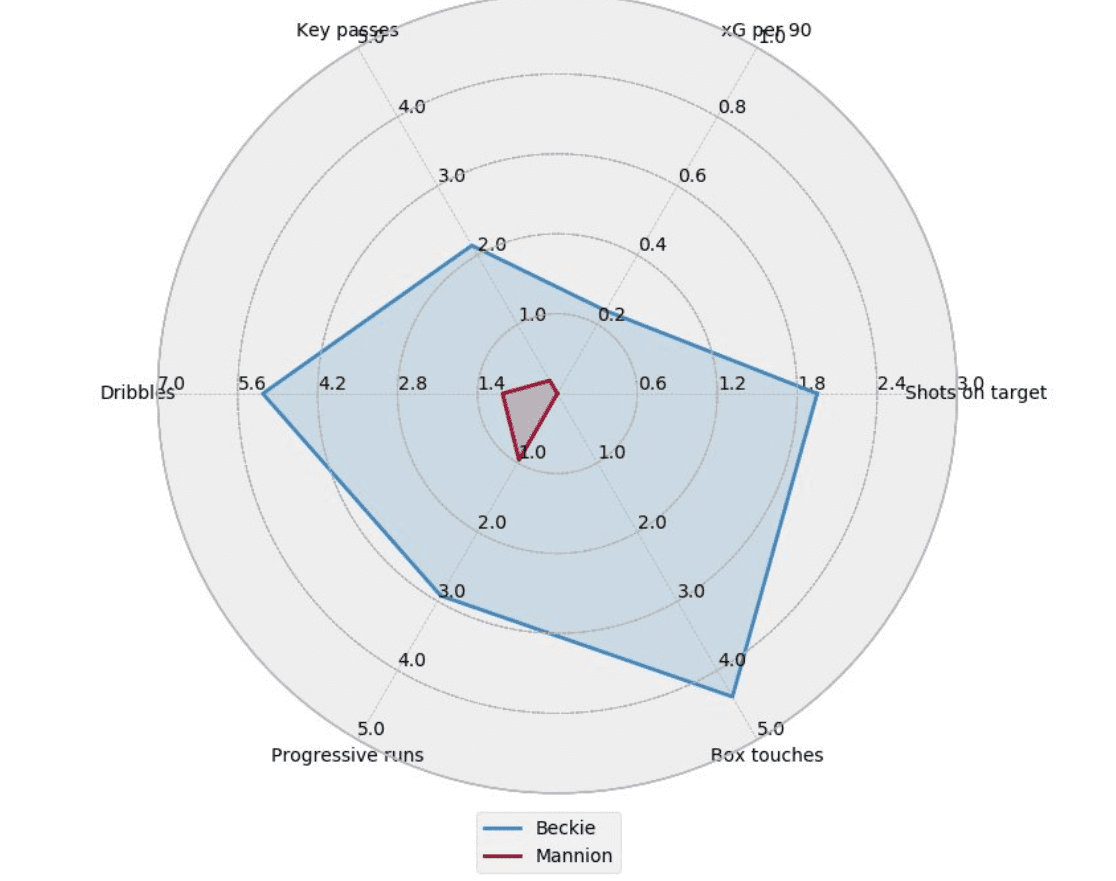
On the other hand, Beckie is miles ahead of Mannion from an attacking perspective. Being a natural forward, Beckie’s attacking instincts were bound to stand out regardless of her playing position. While her dribbles and progressive runs are reminiscent of an attacking full-back, her number of touches in the box stand out. With over four touches in the box per 90, we can conclude that she spends a lot of her time in the opposition half and more so in the penalty area. Her attacking intent has been the reason for City’s new-found attacking blend that has seen them score a number of goals in the past few games.
Long term plan?
What was initially thought of as an emergency stop-gap move has actually turned out to be an innovative and tactically intelligent move by Cushing. The City manager may have had an idea of what he wanted from this change but the effect this move has had on the entire team has been nothing short of positive. While there is extra work needed in a defensive capacity, the change in system supports the move with Walsh, Scott, and Weir playing a bit closer to the defence. When Mannion eventually returns, Cushing will have a host of tactical options at full-back which can be rotated based on the type of challenge they face. For now, the Beckie experiment is proving to be a rousing success.






Comments